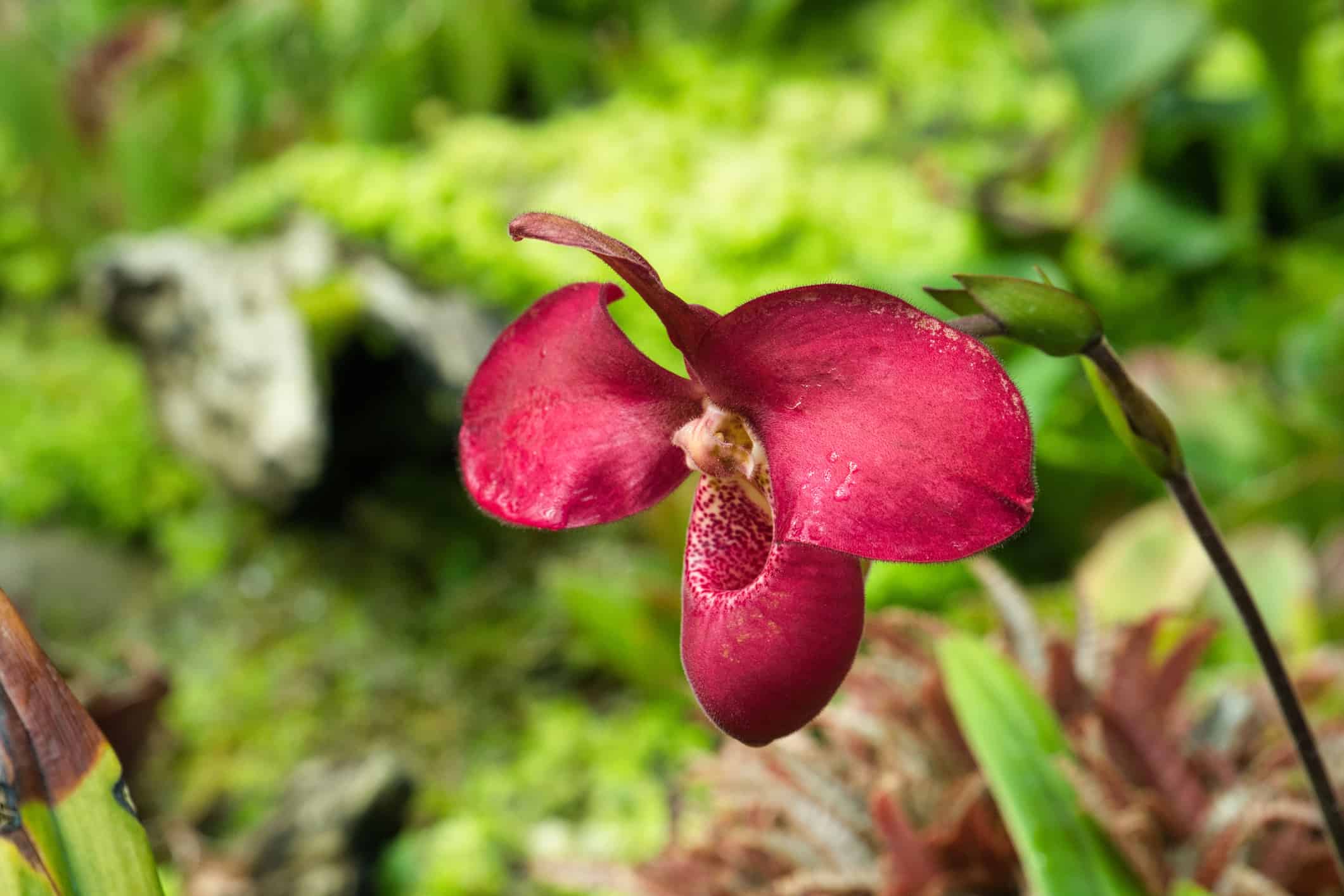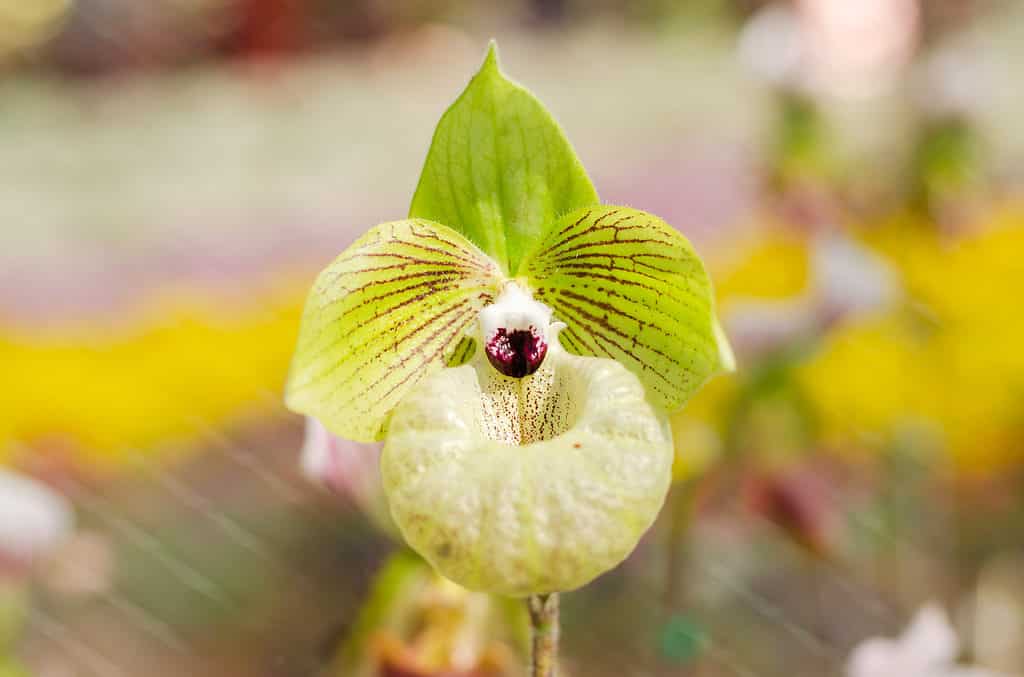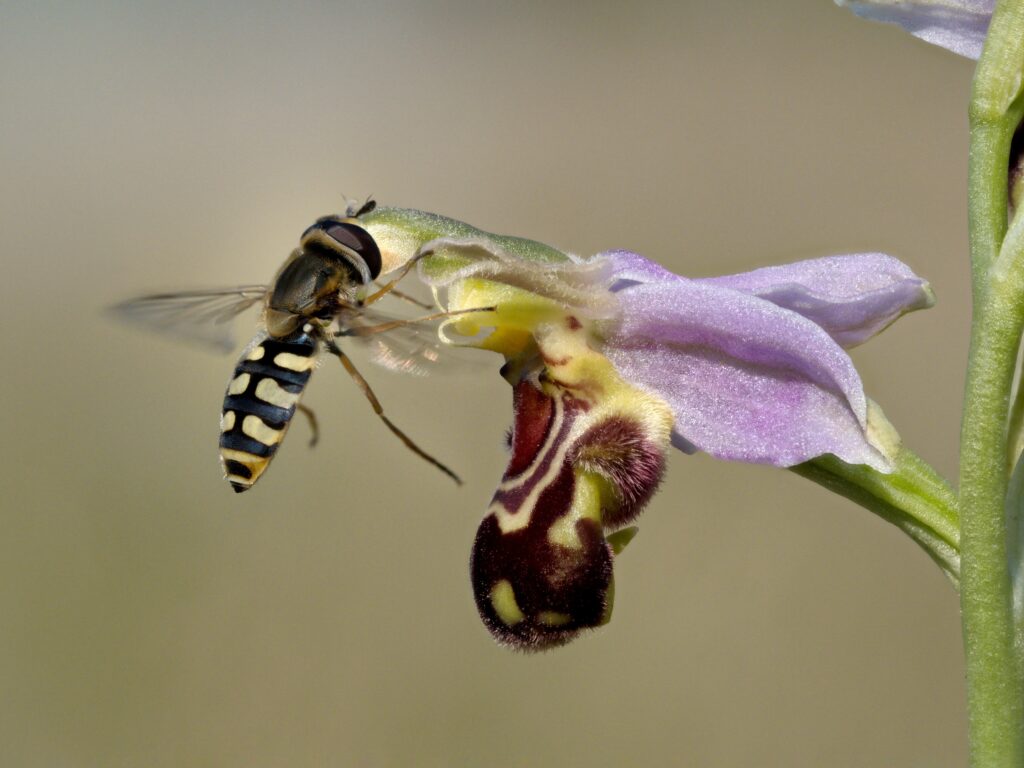Evolving over millions of years to masterfully attract pollinators, orchid flowers produce a highly diverse range of stunning colors, shapes, and fragrances. While we aren’t the intended recipients of these adaptations, humans have fallen in love with the beauty of orchid flowers. Now, we cultivate them widely around the world. For orchid growers of all levels, understanding the evolutionary role of orchid flowers and how to promote healthy blooms will help to ensure that your plant thrives.
In this guide, we’ll cover the botanical classification and brief evolutionary history of orchids. We’ll then jump into describing their unique flower structure, how they function to attract pollinators, and ways to encourage blooming in cultivation.
Let’s get to it!
Orchids: Botanical Classification and a Brief History

Because 30,000 species and 880 genera comprise the orchid family, orchids are diverse and varied flowering plants. Pictured is a
Phragmipediumorchid.
©iStock.com/Wirestock
With almost 30,000 species across 880 genera, the Orchidaceae family is the most diverse family of flowering plants on Earth. This family has evolved over a period of almost 120 million years to thrive in a range of climates and habitats. While they started out as terrestrial plants, likely emerging in Asia, by 35 million years ago they had evolved to become mostly arboreal species that live attached harmlessly to the bark of trees (epiphytic).
This evolutionary development proved to be majorly successful for orchids. Today, about 80% of all orchid species are epiphytes living in tropical and subtropical climates. While the majority of orchids today are warm-loving epiphytes, the rest either continue to thrive living in the soil or have adapted to being lithophytes, attaching themselves to rocks.
Another major evolutionary innovation occurred at some point prior to 64 million years ago. At that point, orchids developed the ability to combine their pollen into sticky structures called pollinia. This development increased the chances of pollen staying attached to pollinators as they make their way to other orchid flowers. We’ll take a deeper look at the structure of orchid flowers and how they’ve adapted to be masters of mimicry and deception.
The Anatomy of Orchid Flowers

Orchids look different from one species to another, but most share the same structure, which defines it as an orchid. Pictured is a jade slipper orchid.
©WindOfHope/Shutterstock.com
Orchid flowers can look quite distinct from species to species. The vast majority, though, share a fundamental structure that defines an orchid bloom. This composition is defined by the following:
- Two lateral petals that are situated as part of the inner composition of the flower.
- Three sepals comprised of the dorsal (top) sepal and two laterals that protect the flower as it matures. They open upon maturity to reveal the inner structure.
- A third, modified lower petal called a labellum, or lip. This structure can emerge in a wide spectrum of shapes and sizes, depending on the species and its pollination strategy.
- A center called a column that contains both the male and female reproductive organs of the plants. The top of the column features the anther, which contains the pollinia. The bottom portion is the stigma, which is a small sticky cavity that receives pollen.
Rarely, you’ll come across orchid species that don’t quite fit into this structure. For example, the tropical orchid genus, Catasetum, produces flowers that are unisexual, meaning they either produce male or female reproductive organs. A plant can either produce only one type of reproductive organ, or it can produce both male and female flowers.
Orchid Flower Pollination Strategies

Most orchids rely on pollinators for fertilization. Pictured is a hover fly pollinating a bee orchid.
©David Osborn/Shutterstock.com
97% of orchids need a pollinator to ensure the transfer of their pollen and to ensure successful fertilization. They produce compact clumps of pollen, called the pollinia, which are not compatible with wind pollination. Instead, orchids rely upon attracting pollinators through two main strategies: deception and reward. We’ll look at both of these strategies in depth below.
Deception
Orchids are masters of mimicry and reproductive deception. This is because they often rely on tricking their pollinators by producing flowers that mimic the shape of an insect or releasing a fragrance that mimics a specific insect pheromone or smells like food for their specific pollinator. About one-third of all orchid species offer no reward to their pollinators and instead rely purely on deception.
Examples of masterful orchid mimics that resemble specific species of female insects to attract male pollinators include Tolumnia henekenii, the copper beard orchid (Calochilus robertsonii), and many species in the Cryptosylis and Ophrys genera.
Examples of fragrance deception include orchids such as those in the Coryanthes and Ophrys genera that dupe male insects into transferring their pollen by releasing fragrances that mimic specific female insect pheromones. One strange orchid, Satyrium pumilum, has a flower that smells like rotting meat to attract its pollinator of choice: sarcophagid carrion flies. Orchids in the Dracula genus produce labellums that mimic the scent and sight of oyster mushrooms to attract fruit fly pollinators.
An entire subfamily of orchids, Cypripedioideae (lady’s slipper orchids), relies on luring and tricking their pollinators into falling into their pouch-like labellums. Lady’s slipper orchids typically use brightly colored and fragrant labellums to lure their pollinators into their temporary trap. Once the pollinator falls or wanders into the pouch, it is forced to escape through only one point of exit that results in the pollinia attaching to its back.
Reward
While some species of orchids successfully use deception to attract pollinators, others use reward. In this style of attracting pollinators, orchids engage in a mutually beneficial exchange in which the pollinator and the orchid benefits from pollen transfer. This reward is typically nectar, which many pollinators feed on. Microtis parviflora, for instance, uses nectar to lure and reward its ant pollinators.
Moths tend to pollinate white-flowered orchids that produce alluring scents at night and have long spurs filled with nectar. Angraecum didieri is an example of a moth-attracting orchid that contains nectar.
Bright pink, red, or yellow orchid flowers that contain nectar often attract butterly orchids. Epidendrum stamfordianum is one such example of an orchid that attracts butterfly pollinators and uses reward as a pollination strategy.
Producing Orchid Flowers in Cultivation

To cultivate orchids, you must understand certain details about the species you’re considering.
©Summer 1810/Shutterstock.com
If you’re growing jewel orchids or mottle-leafed paphiopedilums, you may be entranced by the beauty of their foliage. Most orchid growers, though, are specifically interested in cultivating orchids for their stunning blooms. So, naturally, you’ll want to know how to encourage the most vibrant and healthy flowering of your orchid plants.
Helping your plant produce lovely blooms requires understanding a few key things:
- What species are best suited to growing in your environment.
- What growing conditions are required for flowering.
- The importance of fertilizing.
Some species of orchids may survive in climate zones outside of their native conditions, but they often won’t produce flowers. To ensure flowering, you’ll need to understand the native environment of your orchid species and determine if you can replicate that environment either inside or outdoors.
If you can adequately replicate the environment, the next step is to make sure you’re following culturing guidelines that detail the temperature, light, water, humidity, growing substrate, and fertilizer requirements of the species or genus. You may be watering your Dendrobium orchid adequately. If you don’t provide enough light exposure, though, you’ll fail to see flowering. Or, if you don’t provide cold exposure for species that require it during dormancy, such as cypripediums, you’ll find that spring and summer flowering may be sparse or nonexistent. Following growing guidelines is crucial for beautiful blooms.
Finally, most epiphytic species in particular benefit from consistent fertilizing schedules to thrive, and thus, induce flowering. Fertilizing “weakly weekly” is an important aspect of epiphytic orchid care, as it provides small doses of essential nutrients that your orchid requires for healthy root growth, foliage development, and flowering. Using a balanced fertilizer mix that contains 25-50 parts per million of phosphorus is plenty to encourage healthy blooming.
The photo featured at the top of this post is © iStock.com/wisan224
Thank you for reading! Have some feedback for us? Contact the AZ Animals editorial team.






